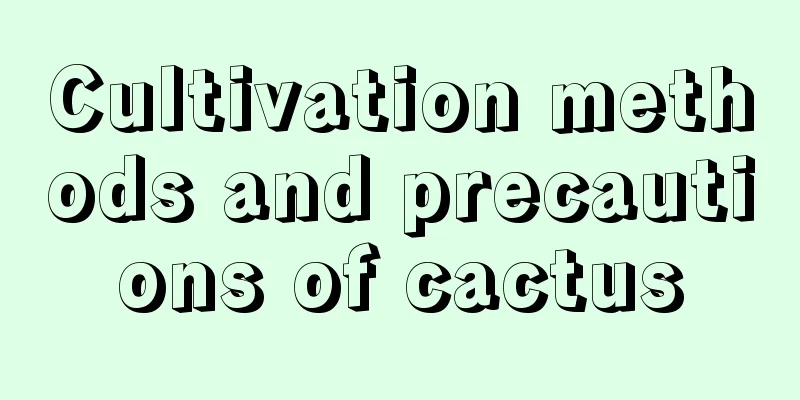Konjac planting methods and management techniques (key points for konjac planting to prevent rot and high yield)

Selection of cultivation site1. Konjac is a high-yield crop. It is greedy for fertilizer and water, but afraid of drought and waterlogging. According to the characteristics of konjac, it should be cultivated in well-drained, conveniently irrigated, shaded mountain land, half-slope forested land on both sides of the river valley, corners of fields, gaps in front and behind houses, and underground in sparse forests. In plain areas, it can be interplanted with tall crops such as corn and sorghum. Choose soil that is deep, loose and fertile, high in organic matter, and PH 6.5-7.5. 2. After selecting a good planting site, deep plow the soil 30-40 cm in the winter of the previous year to allow the soil to weather and mature, and prepare the land before planting in spring. While preparing the land, apply 3,000-4,500 kg of decomposed farmyard manure or soil fertilizer, 50 kg of superphosphate or calcium magnesium phosphate fertilizer, and 50 kg of potash fertilizer or rapeseed cake, cottonseed cake and other oil cakes per mu. Turn them into the soil as base fertilizer and harrow it thoroughly. Then make a high ridge 13 meters wide, dig a 40-centimeter-wide ditch, and arrange drainage ditches around it. Selection and processing of konjac seeds1. Cultivation timeKonjac is sown in spring from March to April, and can also be planted in autumn from August to September. 2. Selection of seed stemsSelect small tubers weighing 50-150 grams, intact and without damage, full buds, and free of pests and diseases as seeds. 3. DisinfectionBefore planting, dry the seed blocks in the sun for 1-2 days. After the moisture is slightly dry, soak the seeds in 400 times diluted 50% carbendazim or 500 times diluted 50% thiophanate-methyl for 15-20 minutes. After drying, plant the seeds. How to grow konjacDig holes or dig furrows on the prepared bed surface with a row spacing of 40-50 cm and a plant spacing of 25-33 cm. Plant one large seed stem and two small seed stems in each hole, with the buds facing upward. After planting, cover the buds with a layer of fine soil 3-4 cm thick. Finally, cover the bed with grass to retain moisture and facilitate germination. Plant 2,000 to 3,500 nests per acre. Key points of konjac field management technology1. Cultivation, weeding and topdressingAfter the cultivation survives or when the konjac turns green and leaves out in spring, combine it with the first inter-row cultivation and weeding, and apply a topdressing fertilizer to promote seedling growth. Apply 1,000 kg of decomposed human and animal manure per mu, or 5-10 kg of urea mixed with 1,000 kg of water. The second intertillage and weeding is in May, the third in June, and the fourth in August. Combined with intertillage, 2000-2500 kg of decomposed human and animal manure water is applied per mu, or 25 kg of compound fertilizer and 2000 kg of water are used for irrigation. 2. Drainage and irrigation waterKonjac likes shade and humidity, so the soil should be kept moist when planting it. If there is a dry season, it should be irrigated in time. In the rainy season, it should be drained in time to prevent root rot. 3. IntercroppingWhen growing konjac, you can interplant tall plants such as corn and sorghum between the rows. This can provide shade for the konjac and avoid direct sunlight, while also increasing income. Harvest management after high-yield konjac planting1. Harvesting: It is harvested 1-2 years after cultivation, in late October, when the aboveground stems and leaves of konjac wither and fall over. Falling over is an important sign of konjac maturity. It is not advisable to dig it up immediately after the aboveground stems and leaves fall over. Wait until around November for the highest yield. Generally, choose a cloudy day, cut off the dead leaves first, carefully dig out the underground stems to avoid damage, and then transport them back for processing. Each large konjac is surrounded by many small konjacs that are reproduced asexually. They must be carefully dug out as seeds, and the konjacs used as seeds must keep the top buds intact. 2. Storage: Place the selected konjac seed blocks in the sun to dry the surface moisture. If there are any damaged ones, the wounds must be rubbed with wood ash and stored separately. They must not be mixed with undamaged konjac seeds. |
Recommend
What is the difference between Fangfeng and Guizhi
1. Leaf Difference The leaves of the windproof pl...
Is rosemary suitable for deep or shallow pots?
Should I use a deep or shallow pot for rosemary? ...
Is Milan flower poisonous?
Milan flowers are not poisonous Many people have ...
When is the Phalaenopsis flower blooming period? Can fertilizer be applied during the Phalaenopsis flower blooming period?
1. When is the flowering period? The flowering pe...
Can honeysuckle leaves be boiled in water? What are the benefits of boiling leaves in water?
1. Can the leaves be boiled in water? Of course, ...
How to grow hydroponic succulents
Hydroponic succulents are a special form of soill...
The correct maintenance method of red
After the impatiens blooms, the flowers are very ...
Introduction to the use and operation steps of cake fertilizer (scientific application of cake fertilizer as topdressing)
What is cake fertilizer Cake fertilizer is actual...
The advantages and disadvantages of Luoyi Rose
The name of Luoyi rose is taken from the poem wri...
How to make Magnolia grandiflora bonsai
Planting techniques of Magnolia grandiflora bonsa...
How to repot the newly bought pennywort? The pennywort wilts after repotting
1. Loosen the soil and remove the pot Newly purch...
How to trim money string
When to trim money strings Money tree can general...
How to take care of the newly bought bird's nest
1. How to take care of the newly bought bird'...
How to grow and water lilies
The ideal growth temperature range for lilies is ...
How to repot white orchid
1. Time If you want to repot it, it is best to wa...









